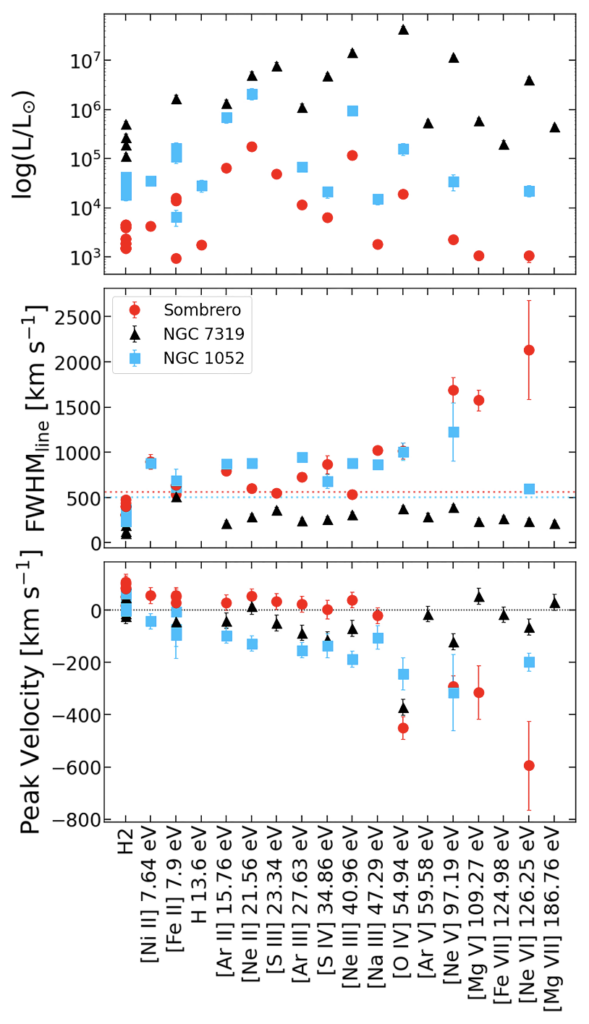Title: ReveaLLAGN 0: First Look at JWST MIRI data of Sombrero and NGC 1052
Authors: Kameron Goold, Anil Seth, Mallory Molina, et al.
First Author’s Institution: Department of Physics & Astronomy, University of Utah
Status: Submitted to ApJ [open access]
Faint but Plentiful
If you’ve been keeping up with Astrobites this past year, chances are that you’ve seen bites on JWST observations of accreting supermassive black holes (SMBHs). We call these SMBHs that are growing through gas accretion “active galactic nuclei” or AGN for short. AGN provide astronomers with key information about how black holes grow and also how this growth is linked with the evolution of galaxies. However, the AGN studied in those papers all have something in contrast with the paper we’re going to talk about today – they are all gobbling down material (i.e. accreting gas) at a much faster rate. This lower accretion rate, along with some complex accretion physics in this regime, means that the AGN we’re discussing today appear much fainter and are therefore often called low luminosity AGN (LLAGN; see this Astrobites guide for more information on AGN classification).
Although these LLAGN are faint, they are mighty in number. In fact, the majority of accreting SMBHs in our local universe are thought to be LLAGN! Despite their prevalence, LLAGN have been historically poorly understood, partially because their low accretion rates makes them difficult to study. Never fear, though – our fancy new space telescope, JWST, is here to help!
Revealing Low Luminosity AGN with the ReveaLLAGN Program
Today’s paper is the first on the ReveaLLAGN program, an approved JWST study of seven LLAGN in the local universe. The authors study the data from the first two targets in this program, NGC 1052 (the brightest target in the sample) and the Sombrero galaxy (the faintest target in the sample). JWST, which studies the universe in infrared (IR) light, provides two crucial improvements upon past telescopes for studying these LLAGN. First, it’s extremely sensitive, which means that good data can be acquired on even these quite faint sources. Second, the angular resolution of JWST is exquisite, and this allows for the AGN emission to be separated from the host galaxy light, which again is crucial when the AGN is not that bright! The authors of today’s paper were awarded JWST time to get unprecedented observations of LLAGN in the local universe. Figure 1 shows the resulting nuclear spectra of NGC 1052 and Sombrero, along with a comparison to a more rapidly accreting AGN that has also been observed with JWST, NGC 7319.

Emission Lines Galore!

As can be seen in Figure 1, the spectra of these LLAGN reveal a wealth of emission lines associated with various atomic species! Emission lines are common among AGN, and their fluxes, line shapes, and ratios are very useful for unlocking the underlying physics that creates them. Many of these emission lines are associated with ions with fewer than the expected number of electrons for a given atom. These atoms can be ionized by various processes, including emission from the AGN, shocks from jets, and radiation from young, hot stars. Looking at which ions exist can tell you about which of these processes are dominating, and an important property that allows us to quantify this is the ionization potential (IP). The IP is the energy required to remove an electron to create the ion, and the presence of emission lines from high IP species means that there must be some very energetic radiation around. Often, seeing lines from high IP species means that there is an AGN around, as accretion is one of the most powerful radiation mechanisms!
In Figure 2, the authors show the luminosity, widths, and peak velocity of the emission lines in the JWST spectrum, as a function of the IP. This figure highlights a number of important points in this paper. First, Sombrero shows some of the faintest high IP lines ever detected! Also, both Sombrero and NGC 1052 show relatively low luminosities of [Ne V] and other high IP lines, which is likely due to the low luminosity of these sources and the lack of high energy photons to do the ionizing. The authors also find that the lines in both sources become both wider and more blueshifted with increasing IP, which is suggested to be a result of outflows, whereby material is flung out from close to the SMBH to very large scales. The launching mechanism and nature of these outflows informs how SMBHs influence their environments, and the authors pinpoint either jets or disk winds as potential driving mechanisms for the outflows in these two LLAGN.
The Past and the Future
This paper shows us that there is lots to be learned about LLAGN with JWST! Figure 3 highlights the vast improvement with JWST by comparing the new JWST spectrum of Sombrero to an old Spitzer observation. Not only does this show that the higher spectral resolution of JWST allows for many more emission lines to be seen, but it also shows the ability of JWST to disentangle the host galaxy contribution from the integrated spectrum to probe the true nuclear emission! This is an exciting step forward in our understanding of the low accretion regime of SMBH accretion. Luckily, there’s already a promise of more to come; 5 more LLAGN will be observed with JWST to round out the ReveaLLAGN sample, so stay tuned for more exciting details on these faint, but mighty cosmic beasts!

If you’re interested in learning more about the details behind this paper, the authors also recently presented this work here.
Astrobite edited by Pranav Satheesh
Featured image credit: Optical: NASA/Hubble Space Telescope/Hubble Heritage Team (STScI), IR: NASA/JPL-Caltech/R. Kennicutt (University of Arizona) and the SINGS Team, JWST: NASA GSFC/CIL/Adriana Manrique Gutierrez, wand: Douglas Santos/Ryan Kaldari (WMF)




